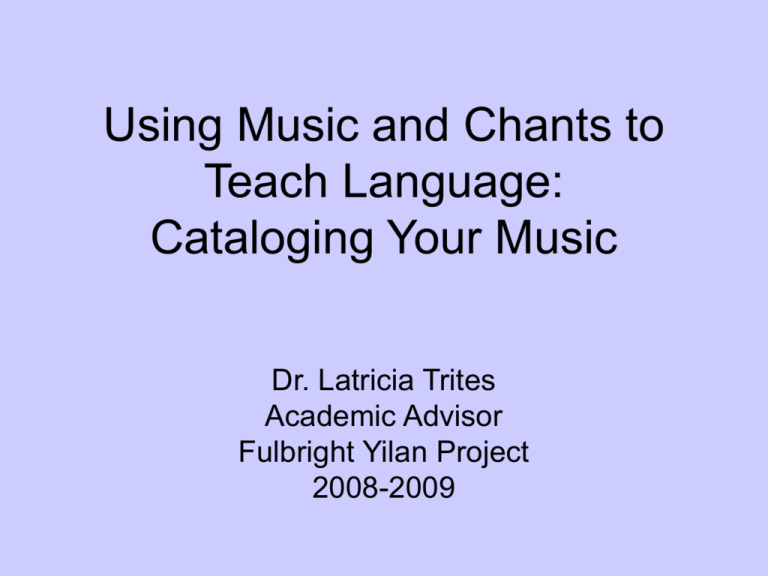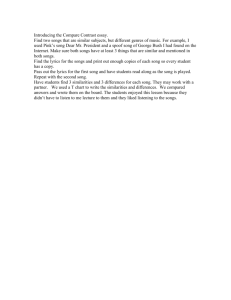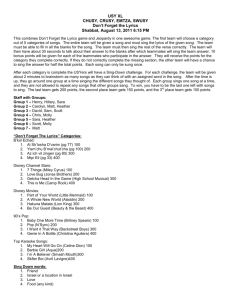Using Music, Chants, and Poems to Teach Language
advertisement

Using Music and Chants to Teach Language: Cataloging Your Music Dr. Latricia Trites Academic Advisor Fulbright Yilan Project 2008-2009 Think Back • What chants do you remember learning as a child? (jumping rope, cheers, etc.) – Peas Porridge Hot… – Cinderella dressed in “yella”… • What songs did you learn? – Clean up… – It’s time to wake up… – London Bridge – Ring Around the Rosy Why Music and Chants? • Motivation Issues – Song/Chants are fun – Songs are a part of any culture – Students sing in groups, no fear of being singled out • Language Issues – – – – – – Stress Patterns Intonation Rhythm Language Chunks Colloquial Expressions Common Dialogues • Learning Issues – Songs stick in our memory – Songs are repetitious Write Your Own Chants • Think of a common expression, activity, or concept that you want the students to learn. • Keep your chant simple with only 3 to 4 beats per line. • Keep the chant simple with only one concept or idea. • Take a few moments and write a NEW chant that you could use for your classroom. DOs • • • • Do lead in activities to introduce topic of song or chant, to introduce important vocabulary. Sing or chant it through once or twice first for students. Give them a simple task while they are listening - watching you do the actions may be a task in itself - you could be their best visual support! Encourage students to think of the most appropriate actions to accompany the words this will give them some ‘ownership’ of the song and make it more memorable. Build up to the whole class singing or chanting on their own. Here are some ideas: – practice slowly at first to work on pronunciation – have students repeat (singing or saying) each line after you - though depending on the song, it may be better to practice verse by verse so as not to break spontaneity – do some extra practice with bits that go fast or have tricky rhythm – you sing the song and students do the motions only – you chant or sing one line/verse and students do the next • • • • students clap or click their fingers to the beat while you chant or sing. let them see the words and work on meaning through visuals, mime examples etc. finally sing the whole song through a couple of times with you and/or on their own. And do some follow-up activities: Writing the words, filling in the gaps, writing an extra verse, changing words, drawing pictures, Oral activities using language in the chant or song. do a final round of the song at the end of class! (www.britishcouncil.org/hongkong-eltnetwork-tips-for-using-songs-ho.doc) DON’Ts Don't over-teach as you may ruin the fun of the song or chant. Don't introduce too many new vocabulary items - 6 may be enough Don't choose a song unsuitable for the students' age group/level. Don't select a song you hate. It will show! Don't expect students to join in immediately. Don't teach a song for which you can't remember the words! (www.britishcouncil.org/hongkong-eltnetwork-tips-for-using-songs-ho.doc) Cataloging your Songs • Think about what your songs can teach – – – – – – – – Vocabulary Culture Grammar Discourse (dialogues) Sentence Structure Morphemes (word formation) Phonemes (sounds – Phonics) Stress, Rhythm, Intonation • Create a catalog for your songs so that you can easily access them for teaching Cataloging Activity • Look at the song “Part of Your World” from The Little Mermaid • Complete the catalog worksheet finding the different things that can be taught through this song. Teaching with Songs Suggestions • Make sure songs are age appropriate – Disney Sing-a-longs – High School Musical • Check to make sure the lyrics are correct • Teach the song using a cloze activity to teach a particular grammar point or vocabulary list. • Slow the song down http://audacity.sourceforge.net/ • Teach only the chorus • www.youtube.com is your friend, also www.teachertube.com Lesson Planning • Take a topic (not Halloween, Thanksgiving, or Christmas). • Find songs that would help you teach that topic (Do not use “Hello/Goodbye” by the Beatles). • Explain how you would use the song to teach the topic or concept. LINKS • http://audacity.sourceforge.net/ • http://www.jaltpublications.org/tlt/files/98/apr/sh_means.h tml • www.britishcouncil.org/hongkongeltnetwork-tips-for-using-songs-ho.doc




